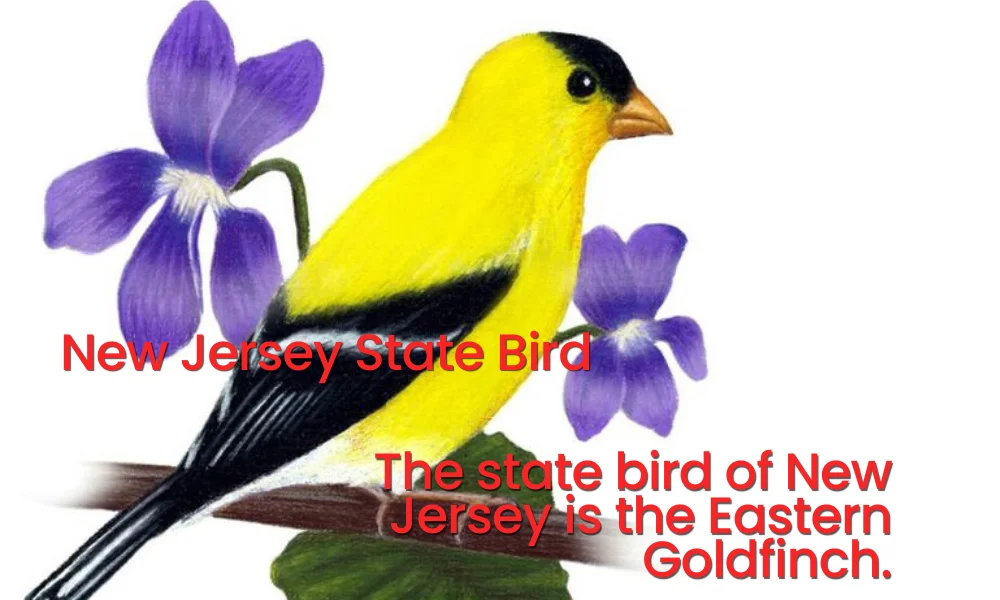New Jersey State Bird
The state bird of New Jersey is the Eastern Goldfinch.
The Eastern Goldfinch, Spinus tristis, is the official state bird of New Jersey. It is often referred to as the American Goldfinch. People who live in New Jersey have a particular place in their hearts for these colourful and happy little birds, which are frequently spotted around the state.
Physical Characteristics: The beautiful look of the little songbird, Eastern Goldfinch, is its most notable feature.
During the summer breeding season, adult males are easily noticeable in fields, meadows, and gardens due to their bright yellow plumage. Their unique appearance is further enhanced by the black feathers on their wings and tail that have white markings.
The plumage of females and non-breeding males, on the other hand, is more muted and olive-brown.
The male Eastern Goldfinch moults into a more muted plumage that matches that of the females during the winter.

They can better blend in with their environment and elude predators thanks to this adaptation. In the spring, they don their bright yellow plumage that they display during the breeding season.
Habitat and Range: Due to their remarkable degree of adaptability, eastern goldfinches can be found in a variety of environments. Open fields, meadows, gardens, and the sides of roads are frequent places to see them.
Since thistle plants make up a large component of their nutrition, they are especially drawn to locations where they are abundant. These little birds can be found all over North America, including New Jersey.
Diet: As stated previously, thistles, dandelions, and sunflower seeds are among the plants that Eastern Goldfinches prefer to eat their seeds from. Their distinctive beak form makes it ideal for removing seeds from these plants’ crowns.
They eat some insects in addition to seeds, particularly in the mating season when they give the insects to their young.
Behavior and Song:
These birds are well-known for their charming and melodic songs, which they utilise for territorial marking and communication. Their song is a delight to hear in the summer and is sometimes described as a succession of happy, descending notes.
Another characteristic of Eastern Goldfinches is their amazing flying routines. Especially during the courtship phase, they can be observed soaring in an undulating pattern and gracefully rising and falling through the air.
Breeding and Nesting: Due to their monogamous nature, Eastern Goldfinches usually start reproducing in late spring or early summer. They often line their nests with the downy seeds of thistle plants when they construct their nests in shrubs and trees.
Usually, the female lays a clutch of three to four pale blue eggs, which she spends roughly two weeks incubating. Following hatching, feeding the chicks is a shared duty between the two parents.
Conservation Status:
Threats to the Eastern Goldfinches are not thought to exist. Their diverse range of habitats and flexible nature help to maintain a stable population.
But much like many other bird species, they might have to deal with issues like habitat loss and climate change, which could have an effect on their long-term survival.
To sum up, the Eastern Goldfinch is a well-known representation of the diversity and natural beauty of New Jersey.
It is a great symbol of the Garden State because of its brilliant colours, upbeat sounds, and flexibility. It grows well in a range of habitats and adds a hint of the natural world to the lives of those who reside in New Jersey.
new jersey state flag
The Flag of New Jersey: A Detailed Overview
The rich legacy and unique character of the Garden State are reflected in the flag of New Jersey, a well-known representation of the state’s history and identity.
The state’s colonial past, Revolutionary War ancestry, and persistent innovative spirit are all reflected in the flag’s distinctive design.
Design and Appearance: The state’s coat of arms is shown in the middle of a dark blue field that makes up the New Jersey flag. The background colour of the coat of arms is buff, or light beige.
For the people of New Jersey, the coat of arms is a source of pride and significance because of its intricate and significant design.
The State’s Coat of Arms: The state coat of arms is displayed in the centre of the flag. The elaborate and detailed artwork represents the history and values of New Jersey. The coat of arms’ principal components are as follows:
- Horse’s Head: The horse’s head at the top of the coat of arms represents New Jersey’s long history of horseback riding and its participation in the Revolutionary War.
- Female Figures: Two female figures flank the head of the horse. The goddess Liberty is represented by the figure on the left, who is wearing a liberty cap, a representation of liberation. The image on the right represents the state’s agricultural past; it is Ceres, the Roman goddess of agriculture, clutching a cornucopia.
- Shield: Three ploughs, symbolising the state’s agricultural heritage, and a blue chief, or upper portion of the shield, signifying the sky, are featured on the centre shield. Additionally, a forward-facing helmet—a symbol of sovereignty—is seen on the shield.
- Supporters: Two female figures, one symbolising liberty and holding a staff with a liberty cap on top, and the other representing agriculture and clutching a cornucopia, support the shield.
- Motto: The state motto, “Liberty and Prosperity,” is embroidered on a ribbon above the shield, indicating the dedication of the state to both prosperity and freedom.
- Compartment: The compartment with the horse facing forward at the base of the coat of arms represents New Jersey’s role in the Revolutionary War and its historical significance as the “Crossroads of the American Revolution.”
Historical Significance: The history of the state is strongly ingrained in the design of the New Jersey flag. New Jersey made major contributions to the war effort and fought in several key engagements during the American Revolutionary War.
This era is honoured by the flag’s usage of symbols like the horse’s head and the mention of the state’s participation in the Revolution.
Legislation and Adoption: On March 26, 1896, the New Jersey Legislature formally adopted the state’s flag. Later, on March 11, 1896, an Act of the Legislature codified the flag’s specifications and design.
Usage and Display:
In the state of New Jersey, the flag is flown with pride at all public gatherings, government buildings, and private homes. It represents the history, identity, and ideals of the state.
In summary, the New Jersey flag is a unique and significant symbol that captures the state’s rich past and unwavering dedication to liberty and prosperity.
The flag, with its distinctive design and intricate coat of arms, is a potent representation of the history and character of the Garden State.

The Violet: New Jersey’s State Flower
The violet, or Viola sororia as it is known in science, is the official state flower of New Jersey.
In addition to being a state flower, this fragile and endearing wildflower is also a common sight in gardens, meadows, and woodlands all around New Jersey.
Physical Characteristics: The violet is a tiny, heart-shaped-leafed perennial wildflower with unusual blue or purple blooms. The violet’s petals have darker veining, which enhances their visual appeal.
These blooms come in a variety of colours, including white, blue, and purple, and typically have a diameter of around one inch. Gardeners and nature lovers love violets for their delicate appearance and modest growth tendency.
Habitat and Range: Because of their extreme adaptability, violets may flourish in a variety of environments, including gardens, meadows, and woodlands.
They are very common in New Jersey’s wooded areas, which are located in both the state’s northern and southern halves. Their broad distribution is a result of their adaptability and capacity to flourish in a variety of soil types and environments.
Blooming Season: In late winter and early summer, violets usually blossom, bringing a burst of colour to the environment as the seasons change. In New Jersey, their presence is a pleasant indicator that spring has arrived.
Symbolism and Cultural Significance:
In New Jersey and elsewhere, the violet has cultural and historical value. It represents a number of important traits, such as modesty, faithfulness, and loyalty.
Violets are commonly connected to feelings of love and affection in the language of flowers. To express these feelings, they are commonly presented as gifts on significant occasions.
Violets hold more symbolic meaning in New Jersey because of the state’s past.
The violet was selected as a sign of New Jersey soldiers during the American Civil War, leading to the moniker “New Jersey’s badge.” The significance of the violet as the state flower is further reinforced by its link to the state’s military past.
Conservation and Preservation:
Like many other wildflowers, violets are not officially listed as endangered, but habitat damage and over-collection pose a hazard to them.
To guarantee that native plant species—like violets—continue to exist in the landscape of New Jersey, conservation and protection efforts are crucial.
Culinary and Medicinal Uses: Violets are useful for culinary and medical purposes in addition to their aesthetic appeal. You can use the edible blooms as a garnish on salads or desserts.
Their flavour is subtle and slightly sweet. Furthermore, violets’ possible medicinal qualities—which include relieving skin irritations and sore throats—have led to their usage in traditional herbal medicine.
In Conclusion:
The violet is a suitable state flower for New Jersey because of its delicate beauty and cultural importance. Its presence in the landscape acts as a constant reminder of the historical legacy and ecological diversity of the state.
The violet, whether it is grown in gardens or found in the wild, is still loved and appreciated by both locals and tourists, adding to the distinctive and vibrant character of New Jersey.
Jason Dare: What happened to him?
Five days after departing from a media medical institution, detective Jason Dare was discovered on March 24.
After a trooper vanished from a Delaware County medical facility, pictures of him went viral, potentially exposing tattoos connected to white supremacist ideology. This prompted the New Jersey State Police to launch an investigation into the matter.
Who is the NJ State Troopers’ chief?
Wikipedia – New Jersey State Police
Colonel Patrick A. Callahan now serves in the Office of the Superintendent, which is the current structure of the New Jersey State Police.
Who is the missing state trooper from New Jersey in Pennsylvania?
A spokeswoman for the New Jersey State Police said that Jason Dare, 46, of Cumberland County, was located safely on Friday morning.
The location and manner of Dare’s discovery were not disclosed by the police. The public was thanked “for your support and your invaluable tips” in a Facebook post by the state police.
Do NJ police officers allow tattoos?
The applicant’s face, head, neck, scalp, hands, or any other exposed bodily part may not have any tattoos, body art, or branding on them.
Was a NJ state policeman discovered safe in Pennsylvania?
Pennsylvania’s Middletown TWP (WPVI) — The New Jersey State Police have reported that a missing state trooper has been discovered safe in Pennsylvania.
“Jason Dare was located in Pennsylvania and is safe. NJSP posted on Twitter, “Thank you all for your support and your priceless advice.
What are the duties of state troopers in New Jersey?
New Jersey Office of Attorney General – New Jersey State Police
It provides statewide enforcement of criminal, motor vehicle, marine and alcohol beverage control laws in addition to general law enforcement services on a contract basis on the New Jersey Turnpike, Garden State Parkway, Atlantic City Motorway, and eighty-nine other state highways. Its general law enforcement jurisdiction spans the entire state.
What is the number of troopers in NJ?
www.njsp.org is the website for the New Jersey Office of Attorney General State Police. The main law enforcement organisation in New Jersey is the New Jersey State Police (NJSP), which has 1,250 civilian and almost 2,800 enlisted members.
The salary of New Jersey state troopers?
What is the salary of a State Trooper at the New Jersey State Police? The average annual salary for a state trooper in New Jersey is roughly $75,499, which is 26% more than the national average.
Who was the trooper who died on Indiana’s Interstate 69?
Bailey, fifty, received word that someone who was dodging Fort Wayne Police officers was approaching his place.
After suffering serious injuries after being hit by the suspect’s car, Bailey started using stop sticks. His wife, son, and daughter survive him; he passed away in a hospital.
Who is the Cherry Hill, New Jersey, missing person?
In Cherry Hill Township, Deborah Redman, the Missing Person, and her two daughters, Aria and Giselle Redman, were found safe.
The public, the media, and the New Jersey Camden County Prosecutor’s Office are all appreciated for their aid with the search by the Cherry Hill Police.
Who is the missing man in Blain, Pennsylvania?
PAUL, BLAIN— For over two years, State Police have been looking for a man from Perry County who has vanished from sight.
According to authorities, 36-year-old Isaac Daniel Seidel was last seen on September 9, 2021, at around 6 p.m. on the 1100 block of Three Springs Road in Blain, Jackson Township.
What is the NJ police maximum age?
Candidates must be at least 21 years old on the application date. Additionally, candidates cannot turn 35 before the date of the academy class graduation.
New Jersey State Animal
The Horse: New Jersey’s State Animal
The horse is the official state animal of New Jersey, a state renowned for its varied terrain and lengthy history.
Because of the horse’s historical significance, contributions to transportation, agriculture, and leisure activities, as well as its continuous presence in the state, New Jerseyans have a particular place in their hearts for this animal.
Historical Significance:
Since the early colonial era, horses have been integral to the history of New Jersey. For the early settlers of the state, it served as their main source of labour and transportation, and it was crucial to the growth of the state’s towns and cities.
Horses were employed to pull ploughs in agricultural areas, operate mills, and transport people and goods.
Horses were essential to both American and British armies in the American Revolutionary War.
Since the state was strategically located at the “Crossroads of the American Revolution,” troops and supplies were moved often, which made horses a vital component of military operations.
Agricultural Contributions:
In the past, horses have played a crucial role in New Jersey agriculture. They were employed in a variety of agricultural tasks, including field ploughing and waggon pulling.
Horses continue to play a vital role in the state’s agricultural economy even now, especially when it comes to equine therapy, recreational riding, and horse husbandry.
Transportation:
Horses were the main means of movement inside and between municipalities in New Jersey before to the invention of automobiles and contemporary public transportation.
They enabled trade and transportation by pulling trolleys, stagecoaches, and carriages. The state’s streets used to frequently feature horse-drawn trolleys.
Leisure and Recreation:
Because of their recreational and leisure value, horses are still loved in New Jersey today. Numerous horse farms, riding schools, and racetracks can be found throughout the state.
Equestrian sports, racing, and horseback riding have all gained popularity in recent years. Known as “The Hunt,” the annual Far Hills Race Meeting is one of the most anticipated horse racing occasions in the state.
Conservation and Preservation:
Although horses are no longer the main means of transportation in New Jersey, attempts to conserve and maintain the state’s equine legacy have been sparked by the horses’ historical and cultural significance.
Horses in the Garden State will always have a place, thanks in large part to the efforts of groups and individuals committed to open space preservation and horse care.
Conclusion: The fact that horses are the official state animal of New Jersey is a testament to the majestic animals’ ongoing relevance in the history, culture, and day-to-day activities of the state.
Horses are revered and loved as a symbol of New Jersey’s rich history and connection to the natural environment, from their vital role in transportation and agriculture to their ongoing presence in leisure activities.
New Jersey Transit
Operating an extensive network of bus, light rail, and commuter rail services throughout the state of New Jersey, NJ Transit is a state-owned public transportation provider.
One of the biggest and most extensive public transport networks in the country was founded in 1979 and is called NJ Transit.
It is essential to the provision of transport services to New Jerseyans and commuters, linking them to different locations both inside the state and outside of it.
Key Features and Services:
- Commuter Rail: Large employment hubs in New York City and Philadelphia are connected to numerous New Jersey towns and communities by the extensive commuter rail network operated by NJ Transit. The Raritan Valley Line, the North Jersey Coast Line, and numerous additional services are among them.
- Bus Services: New Jersey’s suburban, rural, and metropolitan areas are all served by NJ Transit’s bus network. It connects neighbourhoods and gives access to transit hubs and other modes of transportation by providing local and express bus services.
- Light Rail: The organisation runs light rail lines in Hudson County, Jersey City, and Newark, providing a practical form of transit within these cities.
- Access Link: If a person has a disability and cannot use the standard bus or light rail services, NJ Transit offers a specialised paratransit service called “Access Link”.
- Ferries: NJ Transit offers ferry services that connect Manhattan with areas along the Hudson River, giving commuters an alternate mode of transit.
- Service to Sporting Events: In order to accommodate huge crowds, NJ Transit frequently offers special service to athletic events, such as professional football and baseball games.
- Customer-Focused Initiatives: The organisation has launched a number of customer-focused programmes, like the MyTix smartphone app, which makes utilising public transit more convenient by enabling users to purchase and display tickets with their cellphones.
Challenges and Improvements: Over the years, NJ Transit has encountered difficulties, such as worries about budget, infrastructure upkeep, and service dependability.
In order to give its customers better and more dependable transport services, the organization has been trying to resolve these problems and implement changes.
Interconnectivity: NJ Transit is essential to both the state’s economy and the daily lives of its citizens.
As a link to the larger transit network, which includes Amtrak, local bus services, and New York City’s subway system, it is a crucial part of the region’s overall transportation system.
In conclusion, with a wide variety of public transportation alternatives, New Jersey Transit is an essential lifeline for the people of New Jersey. Through its services, communities across the state and beyond are connected, traffic congestion is lessened, and ecologically responsible travel options are offered.
NJ Transit continues to be an important and dynamic force in the state’s transportation environment as it makes improvements and adjusts to the changing requirements of its riders.

